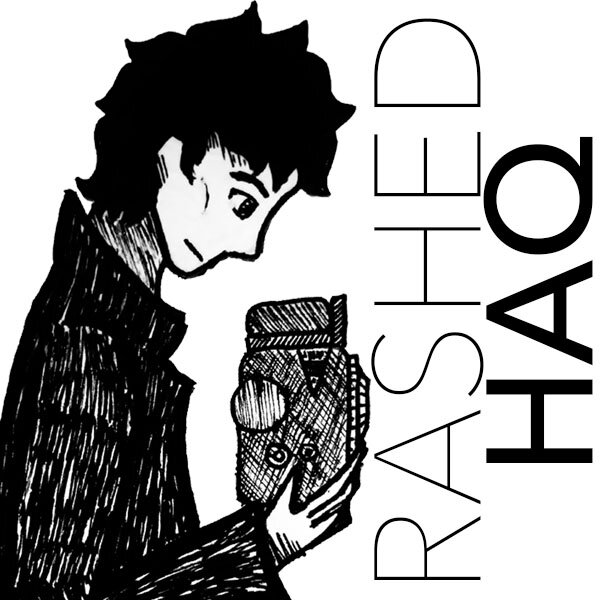Stray Dog Photographs
It was a little after midnight in Old Delhi, and I was walking down an alley behind the Jama Masjid across from the Red Fort when I came across two stray dogs (image 1). The scene reminded me of my favorite photographs of stray dogs, vivid images that have stayed with me. These images each have qualities that repeatedly draw the viewer back to them — a hallmark of great photographs.
Image 1: © Rashed Haq, 2013.
Image 2: © Josef Koudelka, 1987. Parc de Sceaux, Hauts-de-Seine, France.
The startling juxtapositions of Josef Koudelka’s “Parc de Sceaux” come to mind. The image graces the cover of his book Exiles. A Magnum photographer since the 1970s, “he photographed the gypsy population, minority groups, and everything that is destined to become extinct, to be ‘exiled’ in some way.” The high contrast of the silhouette against the snow hides the dog’s expression — making it unclear if it is playful or menacing, while the pose gives it a prowling kind of energy.
Image 3: © Daidō Moriyama, 1971. Stray Dog, Misawa.
The claustrophobia in Daidō Moriyama’s “Stray Dog” is haunting. Moriyama, a Japanese photographer who captures the “darker sides of urban life and the lesser-seen parts of cities,” showing “how life in certain areas was being left behind the other industrialized parts.” The dog’s bared teeth and powerful build gives it a menacing look, and the close cropping of the image makes the viewer feel as if there might not be room enough to escape should the threat materialize.
Image 4: © John Divola, 1998. Dogs Chasing My Car in the Desert.
John Divola photographed stray dogs chasing his car as he was shooting isolated houses in Southern California. He says that when he saw a dog coming toward the car, he “would hold the camera out the window and expose anywhere from a few frames to a complete roll of film” while steering the car with his other hand. In his photograph, “Dogs Chasing My Car in the Desert,” the dog and foreground are motion-blurred, showing the dog’s power and speed, and perhaps also its overwhelming curiosity — enough to drive it to spend energy chasing Divola’s car.
Image 5: © Munem Wasif, 2010. A dog is standing in the middle of the road in Old Dhaka.
Munem Wasif, in his book Belonging, captures the daily life and environment of where he lived for some time — Old Dhaka, the historic part of the country’s capital, Bangladesh. The dog stands in the middle of a deserted road at night, watching the viewer, as if it is ready for anything from a pleasant conversation to escaping from the viewer’s aggression.
Image 6: © Alec Soth, 2002. Dog Days, Bogota.
Alec Soth’s book, Dog Days, Bogota includes a number of images of dogs, some of which are almost certainly stray. Soth photographed these images while he and his spouse were staying in Bogota for two months as they finalized adopting their daughter. This image shows a hungry-looking puppy. The viewer can’t help but wonder, does it need help? And that can lead to further fears raised in the viewer’s mind even if the dog does not look dangerous, such as whether the dog can pass on disease. For example, it is estimated that over 20,000 people get rabies from stray dogs every year.
Stray dogs are not a modern concern or object of fascination, with references in the more-than-4,000-year-old Indian text, the Vedas. Perhaps the reason why these images resonate is that they represent metaphors about life. Humans have adopted dogs as beloved pets, while some got left behind, evoking a sense of marginalization similar to our own societies. Most of the dogs in these images are in desolate environments, begging the viewer to question whether we should feel sad for the dogs for their appearance of abandonment, or if they are better off being free from domestication. The dogs appear to have varying levels of health and comfort — we wonder as we see them: are they hungry and in need of help, or will they violently defend themselves from anyone approaching them? Either way, each image gives the viewer an overwhelming sense of resilience — the feeling that these dogs have made it against the odds. This reminds me of a line from Tamara Panici’s poem I Do Not Want to Say This Country Is Not My Home: “a stray dog survives no matter how little we feed it.”
References
Exiles by Josef Koudelka
The World Through My Eyes by Daidō Moriyama
Dogs Chasing My Car in the Desert by John Divola
Belonging by Munem Wasif
Dog Days, Bogota by Alec Soth
Alec Soth’s genesis NFT drop from Dog Days, Bogota






